
Entrance building to the Taj Mahal. (911k)
Here are some of the pictures of palaces, temples, etc that I took on my trip to India in February/March, 1999. There are lots of palaces in India. The most impressive that I saw were the Amber Palace in Jaipur, the palace in Fatehpur Sikri, the Red Fort in Delhi, the Red Fort in Agra and of course the Taj Mahal in Agra. Very interesting too were the temples in Khajuraho with the huge amount of carved stone figures, including a large number of erotic statues.
Orchha was founded in 1531 and remained the capital of the powerful Bundelas Rajputs until 1783, when nearby Tikamgadh become the new capital. It is now a small village. The Jehangir Mahal in Orchha is well worth visiting. It has fantastic murals. The Jehangir Mahal was built by Raja Bir Singh in the 17th century to commemorate the visit of Emperor Jehangir.
The Amber Palace in Jaipur is located on a hill overlooking Jaipur. It was the capital of the Kuchwaha Rajputs from 1037 to 1728. You can take an elephant ride up to the palace. It has beautiful gardens, lots of carved marble and inlay work.
Another imposing site in Jaipur is the Jantar Mantar. Built in 1726 by Jai Singh II, it has dozens of astronomical instruments (called yantars). They are build of masonry, marble, and brass. The largest is a huge sundial. The gnomon (or shadow casting) part is a staircase 30 m (100 ft) high. This is the largest sundial on earth. Other instruments come in pairs that complement each other. Where one of the instruments in a pair has a marble surface, the other is open, and vice versa. This allows you to walk into the instrument in the open areas and look at the shadow on the marble parts and determine where the shadow is with respect to the markings. The shadow is always on the marble surface on one of the instruments of a pair. Most of the markings had astrological purpose, not astronomical. The Jantar Mantar, Jaipur is a UNESCO World Heritage Site.
The palace in Fatehpur Sikri, not far from Agra, was built by the Mughal Emperor Akbar between 1571 and 1585. He had planned this city as his capital but shortage of water compelled him to abandon the city. Within 20 years, the capital of Mughals was moved to Lahore. Fatehpur Sikri has sensational sandstone carvings. Fatehpur Sikri is a UNESCO World Heritage Site. Jaipur City, Rajasthan is a UNESCO World Heritage Site.
The Red Fort in Agra is a massive red sandstone structure. The Red Fort in Agra is a UNESCO World Heritage Site. It was built principally as a military establishment by Akbar in 1565. It was partially converted into a palace during Shah Jahan's time. The emperor Aurangzeb deposed his father Shah Jahan and imprisoned him in the Agra Fort, from where he gazed across at the Taj Mahal, which he had built for his beloved wife. Shah Jahan is believed to have died in the Musamman Burj, a tower in Agra Fort with a beautiful marble balcony, which offers a scenic view of the Taj Mahal.
The Taj Mahal is the show piece of Indian architecture. It was built by the Muslim Emperor Shah Jahan (died 1666 CE) in memory of his dear wife and queen Mumtaz Mahal. The Taj Mahal was constructed over a period of twenty-two years, employing twenty thousand workers. The Taj Mahal is a UNESCO World Heritage Site.
One of the interesting places was Khajuraho with its ancient (9th to 13th century) temples. It is probably best known for its erotic statues on the temples. All the temples have intricately carved statues all around the outside. The erotic carvings make up about 10% of the statues. Khajuraho Group of Monuments is a UNESCO World Heritage Site.
Delhi too has interesting architecture. The mosque in Delhi is the biggest mosque in India. The Qutub Minar is the tallest minaret in India. The Qutb Minar and its Monuments, Delhi is a UNESCO World Heritage Site.
There are many important Buddhist monuments in India. Buddha is believed to have preached his first sermon in Sarnath. Around 500 CE a large stupa was built on that place.
But the large palaces and temples are only a part of the religious life. There are many small shrines and temples were people worship.
All pictures are © Dr. Günther Eichhorn, unless otherwise noted.
From the Taj Mahal entry in Wikipedia:
The Taj Mahal is an ivory-white marble mausoleum on the south bank of the Yamuna river in the Indian city of Agra. It was commissioned in 1632 by the Mughal emperor Shah Jahan (reigned from 1628 to 1658) to house the tomb of his favourite wife, Mumtaz Mahal; it also houses the tomb of Shah Jahan himself. The tomb is the centerpiece of a 17 hectares (42 acres) complex, which includes a mosque and a guest house, and is set in formal gardens bounded on three sides by a crenellated wall.
Construction of the mausoleum was essentially completed in 1643, but work continued on other phases of the project for another 10 years. The Taj Mahal complex is believed to have been completed in its entirety in 1653 at a cost estimated at the time to be around 32 million rupees, which in 2015 would be approximately 52.8 billion rupees (U.S. $827 million). The construction project employed some 20,000 artisans under the guidance of a board of architects led by the court architect to the emperor, Ustad Ahmad Lahauri.
The Taj Mahal is a UNESCO World Heritage Site.





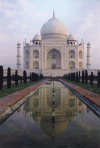



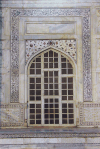











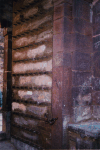

From the Amer Fort entry in Wikipedia:
Amer Fort or Amber Fort is a fort located in Amer, Rajasthan, India. Amer is a town with an area of 4 km² (1.5 square miles) located 11 km (7 miles) from Jaipur, the capital of Rajasthan. The town of Amer and the Amber Fort were originally built by the Mairs, and later it was ruled by Raja Man Singh I. Located high on a hill, it is the principal tourist attraction in Jaipur. Amer Fort is known for its artistic style elements. With its large ramparts and series of gates and cobbled paths, the fort overlooks Maota Lake, which is the main source of water for the Amer Palace.
Mughal architecture greatly influenced the architectural style of several buildings of the fort. Constructed of red sandstone and marble, the attractive, opulent palace is laid out on four levels, each with a courtyard. It consists of the Diwan-e-Aam, or "Hall of Public Audience", the Diwan-e-Khas, or "Hall of Private Audience", the Sheesh Mahal (mirror palace), or Jai Mandir, and the Sukh Niwas where a cool climate is artificially created by winds that blow over a water cascade within the palace. Hence, the Amer Fort is also popularly known as the Amer Palace. The palace was the residence of the Rajput Maharajas and their families. At the entrance to the palace near the fort's Ganesh Gate, there is a temple dedicated to Shila Devi, a goddess of the Chaitanya cult, which was given to Raja Man Singh when he defeated the Raja of Jessore, Bengal in 1604. (Jessore is now in Bangladesh). Raja Man Singh had 12 queens so he made 12 rooms, one for each Queen. Each room had a staircase connected to the King's room but the Queens were not to go upstairs. Raja Jai Singh had only one queen so he built one room equal to three old queen's rooms. A panoramic view of Amer Fort.
This palace, along with Jaigarh Fort, is located immediately above on the Cheel ka Teela (Hill of Eagles) of the same Aravalli range of hills. The palace and Jaigarh Fort are considered one complex, as the two are connected by a subterranean passage. This passage was meant as an escape route in times of war to enable the royal family members and others in the Amer Fort to shift to the more redoubtable Jaigarh Fort.




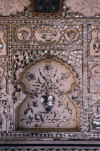
From the Agra Fort entry in Wikipedia:
Agra Fort is a historical fort in the city of Agra in India. It was the main residence of the emperors of the Mughal Dynasty until 1638, when the capital was shifted from Agra to Delhi. Before capture by the British, the last Indian rulers to have occupied it were the Marathas. It is about 2.5 km (1.6 miles) northwest of its more famous sister monument, the Taj Mahal. The fort can be more accurately described as a walled city.
It had been used by the early mughal rulers. The Fort stands on an ancient site and was traditionally known as Badalgarh. It was captured by Ghaznavi for some time but in the 15th century the Chauhan Rajputs occupied it. Soon after, Agra assumed the status of capital when Sikandar Lodi (1487–1517) shifted his capital from Delhi and constructed a few buildings in the pre-existing Fort at Agra. After the first battle of Panipat (1526) Mughals captured the fort and ruled from it. In 1530, Humayun was crowned in it. The Fort got its present appearance during the reign of Akbar (1556–1605).
The Red Fort in Agra is a UNESCO World Heritage Site.







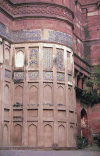
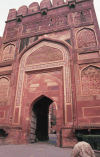





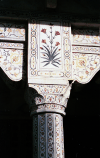


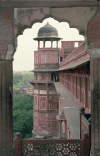
From the Red Fort entry in Wikipedia:
The Red Fort is a historic fort in the city of Delhi in India, which served as the main residence of the Mughal Emperors. Emperor Shah Jahan commissioned construction of the Red Fort on 12 May 1638, when he decided to shift his capital from Agra to Delhi. Originally red and white, Shah Jahan's favourite colors, its design is credited to architect Ustad Ahmad Lahori, who also constructed the Taj Mahal. It was constructed between May 1639 and April 1648.
From the Moti Masjid (Red_Fort) entry in Wikipedia:
The Moti Masjid is a white marble mosque inside the Red Fort complex in Delhi, India. The name translates into English as "Pearl Mosque." Located to the west of the Hammam and close to the Diwan-i-Khas, it was built by the Mughal emperor Aurangzeb from 1659-1660.
From the Shahi Burj (Red_Fort) entry in Wikipedia:
The Shahi Burj (Urdu: Emperor's Tower) is a three-storey octagonal tower of the Red Fort in Delhi.
The tower is located at the northeastern corner of the imperial enclosure. The water feeding, the Nahr-i-Bihisht, is channeled up from the river with a hydraulic system through the tower and then carried by channels into various other buildings of the fort. Adjacent to the south of the tower is a white marble pavilion that was constructed during Aurangzeb's rule. The pavilion features five arches supported on fluted columns and with low whale back roofs. In the center of the north wall is a marble cascade sloping into a scalloped basin.
From the Red Fort entry in Wikipedia:
Diwan-i-Khas: A gate on the north side of the Diwan-i-Aam leads to the innermost court of the palace (Jalau Khana) and the Diwan-i-Khas (Hall of Private Audience). It is constructed of white marble, inlaid with precious stones. The once-silver ceiling has been restored in wood. François Bernier described seeing the jewelled Peacock Throne here during the 17th century.
The Red Fort in Delhi is a UNESCO World Heritage Site.









From the Jama Masjid, Delhi entry in Wikipedia:
The Masjid e Jahan Numa (lit. the "World-reflecting Mosque"), commonly known as the Jama Masjid of Delhi, is one of the largest mosques in India. It was built by the Mughal Emperor Shah Jahan between 1650 and 1656 at a cost of one million rupees, and was inaugurated by Imam Syed Abdul Ghafoor Shah Bukhari from Bukhara, present-day Uzbekistan. The mosque was completed in 1656 with three great gates and two 40 metres high minarets constructed with strips of red sandstone and white marble. The courtyard can accommodate more than 25000 people. There are three domes on the terrace which are surrounded by the two minarets. On the floor, a total of 899 black borders are marked for worshippers. The architectural plan of Badshahi Masjid, built by Shah Jahan's son Aurangzeb at Lahore, Pakistan, is similar to the Jama Masjid.


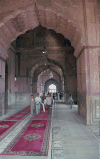
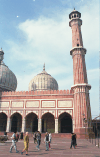



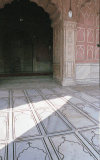

From the Fatehpur Sikri entry in Wikipedia:
Fatehpur Sikri is a town in the Agra District of Uttar Pradesh, India. The city itself was founded as the capital of Mughal Empire in 1571 by Emperor Akbar, serving this role from 1571 to 1585, when Akbar abandoned it due to a campaign in Punjab and was later completely abandoned in 1610.
The name of the city is derived from the village called Sikri which occupied the spot before. An Archaeological Survey of India (ASI) excavation from 1999-2000 indicated that there was a habitation, temples and commercial centers here before Akbar built his capital. The region was settled by Sungas following their expansion. In 12th century, it was briefly controlled by Sikarwar Rajputs.
The khanqah of Sheikh Salim existed earlier at this place. Akbar's son Jahangir was born at the village of Sikri in 1569 and that year Akbar began construction of a religious compound to commemorate the Sheikh who had predicted the birth. After Jahangir's second birthday, he began the construction of a walled city and imperial palace here. The city came to be known as Fatehpur Sikri, the "City of Victory", after Akbar's victorious Gujarat campaign in 1573.
Fatehpur Sikri is a UNESCO World Heritage Site.




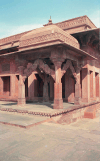






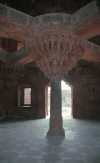
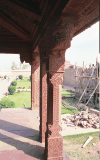

From the Jama Masjid, Fatehpur Sikri entry in Wikipedia:
The Jama Masjid (Friday Mosque) is a 17th-century mosque in the World Heritage Site of Fatehpur Sikri in India. The Mughal emperor Akbar personally directed the building of the Jāmiʿ Masjid (Great Mosque; 1571), which stretches some 165 m (541 ft) in length. The mosque also known as the "Friday Mosque" is one of the largest mosques in India and is a most sought after pilgrimage site by the devotees. It is also one of the most visited tourist destinations in Agra district. Some of the designs of the mosque reflect beautiful Iranian architecture.
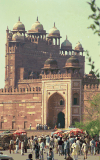

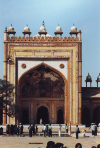




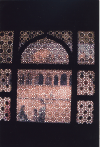
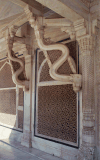
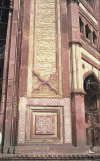
From the Khajuraho Group of Monuments entry in Wikipedia:
The Khajuraho Group of Monuments is a group of Hindu temples and Jain temples in Chhatarpur district, Madhya Pradesh, India, about 175 km (109 miles) southeast of Jhansi. The temples are famous for their nagara-style architectural symbolism and their erotic sculptures.
Most Khajuraho temples were built between 950 CE and 1050 CE by the Chandela dynasty. Historical records note that the Khajuraho temple site had 85 temples by the 12th century, spread over 20 square kilometers. Of these, only about 25 temples have survived, spread over 6 km² (2.3 square miles). Of the surviving temples, the Kandariya Mahadeva Temple is decorated with a profusion of sculptures with intricate details, symbolism and expressiveness of ancient Indian art.
The Khajuraho group of temples were built together but were dedicated to two religions, Hinduism and Jainism, suggesting a tradition of acceptance and respect for diverse religious views among Hindus and Jains in the region.
Khajuraho Group of Monuments is a UNESCO World Heritage Site
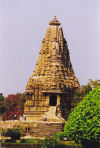




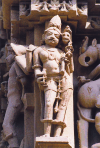

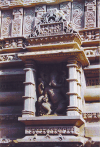
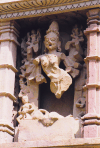
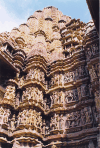
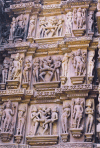


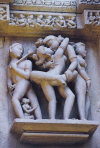

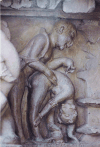


From the Qutb Minar entry in Wikipedia:
The Qutb Minar, also spelled as Qutub Minar, is a minaret and "victory tower" that forms part of the Qutb complex, in the Mehrauli area of Delhi, India. Qutb Minar was 73 m (240 ft) tall before the final, fifth section was added after 1369. The tower tapers, and has a 14.3 m (46.9 ft) base diameter, reducing to 2.7 m (8.9 ft) at the top of the peak. It contains a spiral staircase of 379 steps.
The Qutb Minar and its Monuments, Delhi is a UNESCO World Heritage Site.




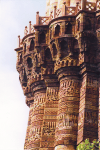


From the Jantar Mantar entry in Wikipedia:
The Jantar Mantar is an equinoctial sundial, consisting of a gigantic triangular gnomon with the hypotenuse parallel to the Earth's axis. On either side of the gnomon is a quadrant of a circle, parallel to the plane of the equator. The instrument is intended to measure the time of day, correct to half a second and declination of the Sun and the other heavenly bodies.
There are five Jantar Mantars in India, of which the largest is in Jaipur which features many instruments along with the world's largest stone sundial. The Vrihat Samrat yantra is a sundial that can give the local time to an accuracy of 2 seconds.
The Jantar Mantar, Jaipur is a UNESCO World Heritage Site.











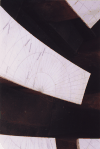

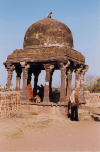
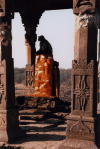

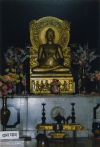







This page contains 137 pictures

Main page for भारत गणराज्य (India)
Page last updated on Fri Dec 2 12:48:22 2022 (Mountain Standard Time)
Page last updated on Wed Apr 24 21:09:20 2024 (Mountain Standard Time)
भारत गणराज्य (India): Architecture on gei.geichhorn.com